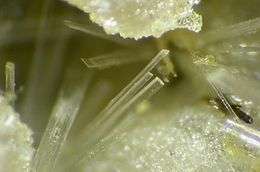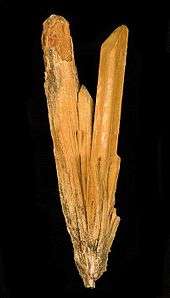Cervantite
Cervantite is an antimony oxide mineral with formula Sb3+Sb5+O4 (antimony tetroxide).
| Cervantite | |
|---|---|
 Microscopic cervantite crystals from Slovakia (3 mm field of view) | |
| General | |
| Category | Oxide mineral |
| Formula (repeating unit) | Sb3+Sb5+O4 |
| Strunz classification | 4.DE.30 |
| Crystal system | Orthorhombic |
| Crystal class | Pyramidal (mm2) (same H-M symbol) |
| Space group | Pbn21 |
| Unit cell | a = 5.43 Å, b = 4.81 Å, c = 11.76 Å; Z = 4 |
| Identification | |
| Color | Yellow to nearly white |
| Crystal habit | Microscopic acicular crystals; massive |
| Cleavage | Excellent on {001}, distinct on {100} |
| Fracture | Conchoidal |
| Mohs scale hardness | 4–5 |
| Luster | Greasy, pearly, earthy |
| Streak | Pale yellow to white |
| Diaphaneity | Semitransparent |
| Specific gravity | 6.5 |
| Optical properties | Biaxial |
| Refractive index | nα = 2.000 nγ = 2.100 |
| Birefringence | δ = 0.100 |
| Dispersion | relatively weak |
| References | [1][2][3][4] |
It was first described in 1850 for an occurrence in Cervantes, Sierra de Ancares, Lugo, Galicia, Spain, and named for the locality.[3] The mineral was questioned and disapproved, but re-approved and verified in 1962 based on material from the Zajaca-Stolice district, Brasina, Serbia.[2] It occurs as a secondary alteration product of antimony bearing minerals, mainly stibnite.[2]

Cervantite and valentinite replacing stibnite from the Xikuangshan Mine of Hunan Province, China (size: 16.1 x 5.0 x 3.0 cm)
This article is issued from Wikipedia. The text is licensed under Creative Commons - Attribution - Sharealike. Additional terms may apply for the media files.